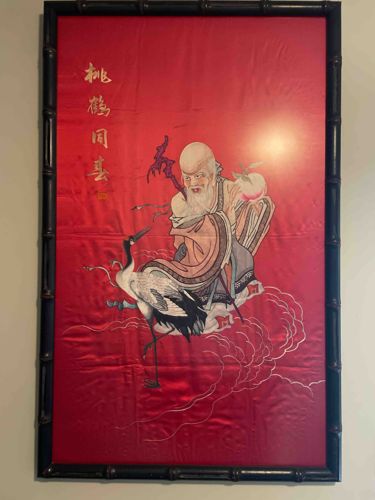
Framed Chinese Silk Embroidery of Shoulao with Crane and Peach
This item is a framed Chinese silk embroidery depicting Shoulao, the God of Longevity, accompanied by a crane and holding a peach of immortality. The embroidery is presented on a vibrant, eye-catching red silk background, which serves as a stark contrast to the figures and provides a sense of dynamism. The central figure of Shoulao is rendered with fine detail, showcasing his characteristic bald, elongated head, long white beard, and expressive features. His robes are depicted in muted tones of peach, grey, and black, with a notable use of textured stitching to give depth and form to the fabric folds. He holds a large, ripe peach in one hand and possibly a staff or scepter in the other, though the latter is less clear due to the angle and possibly the design. Below Shoulao, a majestic red-crowned crane stands gracefully, with exquisite detail in its white, black, and red plumage. The crane's depiction suggests movement or an interaction with Shoulao. Lightly embroidered silver or white wisps, possibly representing clouds or qi (life force), surround the figures, further emphasizing the mythical and auspicious nature of the scene. Chinese characters, likely a poetic inscription or dedication, are embroidered in gold thread at the top left of the silk. The embroidery appears to be hand-stitched, exhibiting a high level of craftsmanship and intricate threadwork, particularly in the fine lines of Shoulao's beard and the crane's feathers. The silk itself shows some signs of gentle creasing or age-related subtle wear, consistent with a textile of some vintage. It is housed in a substantial black frame designed to mimic bamboo, with visible nodes that add to its traditional East Asian aesthetic. The overall condition appears good, with no obvious major tears, stains, or significant damage to the textile, though a direct inspection would be needed to confirm. The frame seems well-preserved with minor scuffs, if any. The piece likely dates from the late 19th or early to mid-20th century, a period known for export-quality Chinese embroidery.
AI-Generated Appraisal Disclaimer
Estimated Value
$600-900
Basic Information
Category
Decorative Arts - Textile
Appraised On
December 14, 2025
Estimated Value
$600-900
Item Description
This item is a framed Chinese silk embroidery depicting Shoulao, the God of Longevity, accompanied by a crane and holding a peach of immortality. The embroidery is presented on a vibrant, eye-catching red silk background, which serves as a stark contrast to the figures and provides a sense of dynamism. The central figure of Shoulao is rendered with fine detail, showcasing his characteristic bald, elongated head, long white beard, and expressive features. His robes are depicted in muted tones of peach, grey, and black, with a notable use of textured stitching to give depth and form to the fabric folds. He holds a large, ripe peach in one hand and possibly a staff or scepter in the other, though the latter is less clear due to the angle and possibly the design. Below Shoulao, a majestic red-crowned crane stands gracefully, with exquisite detail in its white, black, and red plumage. The crane's depiction suggests movement or an interaction with Shoulao. Lightly embroidered silver or white wisps, possibly representing clouds or qi (life force), surround the figures, further emphasizing the mythical and auspicious nature of the scene. Chinese characters, likely a poetic inscription or dedication, are embroidered in gold thread at the top left of the silk. The embroidery appears to be hand-stitched, exhibiting a high level of craftsmanship and intricate threadwork, particularly in the fine lines of Shoulao's beard and the crane's feathers. The silk itself shows some signs of gentle creasing or age-related subtle wear, consistent with a textile of some vintage. It is housed in a substantial black frame designed to mimic bamboo, with visible nodes that add to its traditional East Asian aesthetic. The overall condition appears good, with no obvious major tears, stains, or significant damage to the textile, though a direct inspection would be needed to confirm. The frame seems well-preserved with minor scuffs, if any. The piece likely dates from the late 19th or early to mid-20th century, a period known for export-quality Chinese embroidery.
Related Tags
Explore similar items and categories:
Get Your Items Appraised
Instant estimates of your treasures with AI-powered instant appraisals